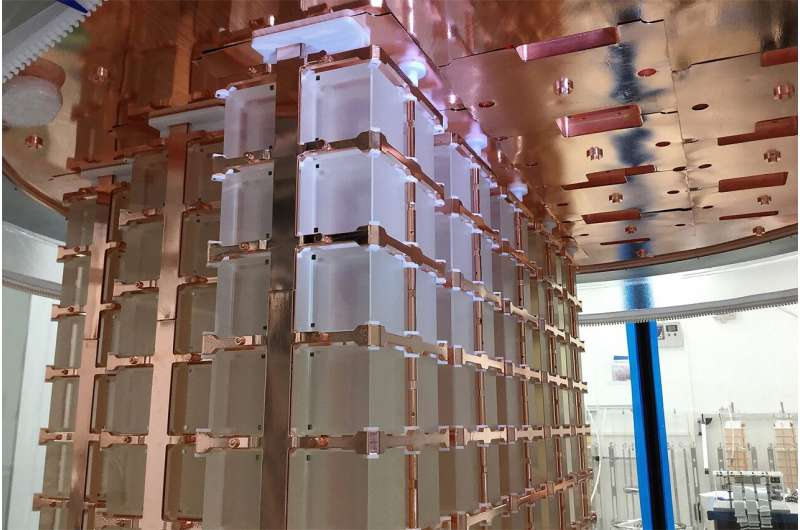Science
Researchers Enhance Neutrinoless Double Beta Decay Search with New Techniques

Researchers at the Gran Sasso National Laboratory in Italy have made significant strides in the search for neutrinoless double beta decay, a phenomenon that could fundamentally change our understanding of particle physics. The team, part of the Cryogenic Underground Observatory for Rare Events (CUORE), has accumulated two ton-years of data in their ongoing effort to explore this rare nuclear particle decay process, which challenges existing theories in the Standard Model of Particle Physics.
New Findings and Innovative Techniques
In a recent study published in the journal Science, the CUORE team established that neutrinoless double beta decay occurs no more than once every 50 septillion years. This measurement is a critical step toward proving that neutrinos, which are fundamental particles, can be their own antiparticles, a concept known as Majorana particles. The significance of this finding lies in its potential to explain the matter-antimatter asymmetry observed in the universe.
To enhance their research, scientists have developed a sophisticated algorithm designed to minimize external noise that could interfere with their data collection. This algorithm filters out vibrations from various sources, including nearby conversations, ocean waves, and seismic activity. As Reina Maruyama, a professor of physics and astronomy at Yale University, noted, “The focus of this data release is understanding sources of external vibrations and learning how to subtract that from our data to better search for this extremely rare decay.”
Operational Challenges and Future Prospects
The CUORE facility is situated nearly a mile underground, encased in lead shielding salvaged from a Roman shipwreck, which helps reduce radiation exposure. Despite this protective environment, some vibrational noise inevitably penetrates, necessitating the implementation of advanced noise-cancelling techniques. The research team has installed over two dozen sensors to monitor temperature, sound, and vibrations near the detector, allowing them to distinguish between useful data and extraneous noise.
The CUORE experiment, initiated in 2017 under the auspices of the U.S. Department of Energy’s Lawrence Berkeley National Laboratory, will continue data collection throughout the remainder of the year. Following this, the CUORE Upgrade with Particle Identification (CUPID) will take over the search for neutrinoless double beta decay. CUPID will enhance the experiment by incorporating improved light sensors and utilizing enriched molybdenum crystals instead of tellurium to refine event identification.
Detecting neutrinoless double beta decay could have profound implications for physics, as it would violate the principle of lepton number conservation and provide compelling evidence for new physics beyond the Standard Model. Karsten Heeger, director of Yale’s Wright Laboratory and a key figure in the CUPID project, emphasized the importance of this research, stating, “This unique nature of neutrinos may explain the matter-antimatter asymmetry in the universe—the fact that there is more matter than antimatter.”
The collaborative efforts in the CUORE and CUPID projects showcase the contributions of several researchers from Yale, including Penny Slocum, Tyler Johnson, James Wilhelmi, and graduate students Ridge Liu, Maya Moore, and Zach Muraskin. Their collective work aims to push the boundaries of our understanding of particle physics and the fundamental composition of the universe.
For those interested in the latest developments in science, technology, and research breakthroughs, the CUORE experiment represents an exciting frontier that could reshape our comprehension of the cosmos.
-

 Entertainment3 months ago
Entertainment3 months agoAnn Ming Reflects on ITV’s ‘I Fought the Law’ Drama
-

 Entertainment4 months ago
Entertainment4 months agoKate Garraway Sells £2 Million Home Amid Financial Struggles
-

 Health3 months ago
Health3 months agoKatie Price Faces New Health Concerns After Cancer Symptoms Resurface
-

 Entertainment2 weeks ago
Entertainment2 weeks agoCoronation Street Fans React as Todd Faces Heartbreaking Choice
-

 Entertainment3 months ago
Entertainment3 months agoCoronation Street’s Carl Webster Faces Trouble with New Affairs
-

 World3 weeks ago
World3 weeks agoBailey Announces Heartbreaking Split from Rebecca After Reunion
-

 Entertainment3 months ago
Entertainment3 months agoWhere is Tinder Swindler Simon Leviev? Latest Updates Revealed
-

 Entertainment4 months ago
Entertainment4 months agoMarkiplier Addresses AI Controversy During Livestream Response
-

 Science2 months ago
Science2 months agoBrian Cox Addresses Claims of Alien Probe in 3I/ATLAS Discovery
-

 Health5 months ago
Health5 months agoCarol Vorderman Reflects on Health Scare and Family Support
-

 Entertainment4 months ago
Entertainment4 months agoKim Cattrall Posts Cryptic Message After HBO’s Sequel Cancellation
-

 Entertainment3 months ago
Entertainment3 months agoOlivia Attwood Opens Up About Fallout with Former Best Friend




















